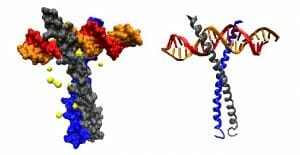Transcription Factor Definition
Transcription factors are DNA-binding proteins that play a key role in gene transcription. They are modular in structure and heterodimeric. Built within the transcription factor is a DNA-binding domain and several sites for the other transcription co-regulators to bind. Transcription factors bind to short conserved sequences located within each promoter along the strands of DNA. Ultimately, transcription factors can be thought of as the “gatekeepers” that determine if a gene is expressed or not. In eukaryotic cells, this is made possible with the help of activator and repressor protein variants.

This figure is a virtual depiction of a Leucine Zipper type transcription factor in complex with DNA.
Activator proteins help to “activate” mRNA transcription by binding to pieces of DNA called enhancers/. Enhancers are essentially short (50-1500 base pair) stretches of DNA that, when bound to activators, make the transcription of a gene more likely. This causes a conformational change in the three-dimensional structure of DNA that brings them closer to a gene promoter to kick-start transcription, even if the promoter was thousands of base pairs away. This builds a transcription initiation complex that can recruit RNA polymerase to initiate transcription. The main purpose of these elements is to bring the factors they bind, closer to the initiation complex. On the other hand, we have repressors that bind directly to the promoter and enhancer regions to physically block transcription. Repressors are physically responsive to external stimuli while corepressors help repress the start of transcription by recruiting enzyme histone deacetylase (this family of enzymes removes acetyl groups from lysine amino acids on histones, allow the histones to wrap more tightly around DNA so that it cannot unravel or allow transcription).
Function of Transcription Factors
The principal role transcription factors play is in allowing cells to differentiate. Through their ability to initiate or repress site-specific transcription, each cell in our bodies can differentiate into a different cell type despite containing the same exact genetic code. Turning genes on or off allows cells to potentiate into the different tissues and organs that make up our bodies. (In fact, embryonic and adult stem cells are a class of undifferentiated cells that can differentiate into the cell type that it is placed next to.)
Transcription factors also make genetic fine-tuning possible. Modulating the activity and the amount of transcription factor can upregulate (increase) or downregulate (decrease) the rates of the chosen gene’s transcription. Therefore, these alterations not only allow a gene to be expressed, but they determine at which level each gene is expressed. For example, when the insulin levels in our blood are elevated, our cells trigger a downregulation in the expression of insulin receptor. So, although insulin receptors continue to be made for life-sustaining purposes, the levels of expression subside to accommodate our body’s new internal conditions.
The method of action is reflected in the classification the factor falls under, as discussed below.
Transcription factor classification
Transcription factors generally fall into three categories, largely depending on their mechanism of action.
- Mechanistic transcription factors rely on their physicality to stimulate or repress the transcription of the selected gene by binding upstream of the initiation site. They are ubiquitous and transcribe all class II genes (which code for proteins via RNA polymerase II).
- Structural transcription factors are classified by sequence similarity and the resultant tertiary structure of their DNA-binding domains.
- Finally, Functional transcription factors are classified by their function and contain several variants.
- Constitutively active factors are present in cells at all times
- Conditionally active factors require activation. Developmental types are tightly regulated until they are expressed and require no additional activation. Signal dependent types require an external influence, whether that is an extracellular (endocrine) or an intracellular (autocrine) ligand or a receptor-dependent cascade of activations.
Quiz
1. Transcription factors have a ubiquitous role in which following process?
A. Translation
B. Transcription
C. Apoptosis
D. Macrophage degradation
2. Define the mechanism of action of the “activator” transcription factors as discussed in this article?
A. Physically blocks RNA polymerase from reaching the designated gene
B. Acts by allowing DNA strands to unravel and expose their DNA binding sites
C. Bind enhancers that change DNA’s conformation to bring the promoter region close to the binding site
D. Dimerize thymine, which attracts RNA polymerase to the binding site to initiate gene transcription
3. Name the three types of transcription factor?
A. Physical, functional, structural
B. Physical, chemical, functional
C. Mechanistic, chemical, structural
D. Mechanistic, functional, structural
References
- Atlas Genetics Oncology (2017). “Transcription factors.”Atlas of Genetics and Cytogenetics in Oncology and Haematology Retrieved on 2017-05-12 from http://atlasgeneticsoncology.org/Educ/TFactorsEng.html
- Boundless (2017). “Enhancers increase the rate of transcription of genes, while repressors decrease the rate of transcription.” Transcriptional Enhancers and Repressors. Retrieved 2017-05-11 from https://www.boundless.com/biology/textbooks/boundless-biology-textbook/gene-expression-16/eukaryotic-gene-regulation-113/transcriptional-enhancers-and-repressors-458-11684/
- Cooper, Geoffrey M (2000). “Eukaryotic RNA Polymerases and General Transcription Factors.” The Cell: A Molecular Approach 2nd edition. Available from https://www.ncbi.nlm.nih.gov/books/NBK9935/
- Dominici FP et al (2002). “Increased insulin sensitivity and upregulation of insulin receptor, insulin receptor substrate (IRS)-1 and IRS-2 in liver of Ames dwarf mice.” J Endocrinol.. 173(1):81-94
- Glover, JN Mark et al (1995). “Crystal structure of the heterodimeric bZIP transcription factor c-Fos-C-Jun bound to DNA.” Nature: 257-61
Transcription Factor
No comments:
Post a Comment